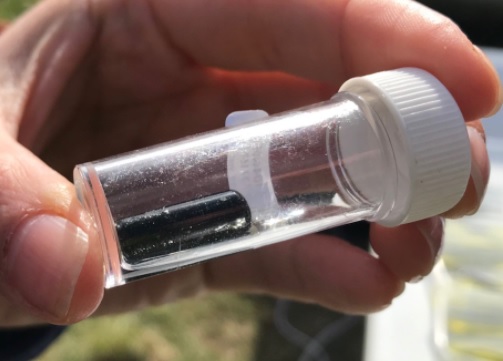K is for Kill: Salmon farming critic, Corin Smith, of Inside Scottish Salmon Feedlots, has several times posted a graphic on his Facebook page which proclaims a number of different statements including: ‘Salmon farms’ and ‘Killing wild Scottish salmon’. The following is my version of his image:

Mr Smith is happy to share his views on salmon farming, not just on his Facebook page, but as we have also seen, on TV and in the Netflix film Seaspiracy. Yet, nowhere has Mr Smith actually provided any evidence that salmon farms have killed even a single wild Scottish salmon.
I accept that research in Norway and Ireland has shown that about one percent of wild salmon stocks might be impacted by sea lice, but the wild fish sector does not accept this figure. One percent mortality would account for a few hundred smolts, yet many more are failing to return to Scottish rivers for other different reasons.
I don’t think it unreasonable to ask for some evidence when such claims are made against the salmon farming industry. I know that Mr Smith’s expertise lies elsewhere than salmon biology, but there are organisations such as S&TC, AST and FMS, and even the Wildlife Trusts, that he could call on for support. Surely between them all, it is not too much to ask for some real evidence that salmon farms are responsible for the deaths of wild Scottish salmon, especially if the industry is being asked to spend many millions of pounds taking remedial action to mitigate against these alleged impacts.
I have been prompted to comment on Mr Smith’s claims by a new analysis of the Scottish Government’s catch data. I would like to share the following image, which is a graph of salmon and grilse catches from Scottish rivers. The data is as supplied by the Scottish Government and has not been manipulated in any way except by adding up the numbers of fish caught from each area.
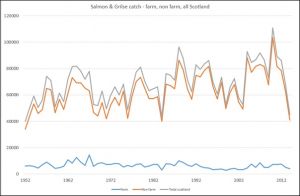
The orange line is the total salmon & grilse catch from all rivers outside the Aquaculture Zone. This includes the east coast, the north coast and the southwestern coast including the Solway Firth. What is interesting is how much it mirrors the grey line which is the total annual salmon and grilse catch of all Scotland. There is a small gap between the two lines, which is relatively similar throughout the whole time series. This gap represents the salmon & grilse catch from rivers within the Aquaculture Zone. On average, the difference is just under 10% of the total, amounting to approximately 6,500 salmon per year. In recent times, several years catches have exceeded this figure suggesting that any mortality due to salmon farming is negligible.
There were a few years during the 1990s that catches fell by about 3,000 fish below the average. According to Marine Scotland Science, this fall is consistent with an impact from salmon farming. However, as they do not record fishing effort as happens elsewhere in the UK, MSS have no idea whether the lower catches are due to reduced fishing effort rather than the impact of salmon farming. During this period, critics, such as the late Bruce Sandison, were claiming that stocks of all wild fish were approaching extinction due to salmon farming. Any angler wanting a week’s fishing on the west coast was likely to heed Mr Sandison’s advice and opted to fish elsewhere. Eventually, word emerged that good catches were still to be had from west coast rivers and anglers began to return and consequently catches started to recover. If salmon farming is responsible for declines of wild salmon, then why did catches then recover, especially at a time, when the industry was undergoing rapid expansion.
On this graph, the west coast catch is represented by the blue line and whilst like the other areas, catches have seen regular annual variations, the overall pattern of catches has remained relatively stable. Of course, in the last decade, catches have since fallen in the west, but so they have across all of Scotland as illustrated by Marine Scotland Science’s graph of Scottish catches.
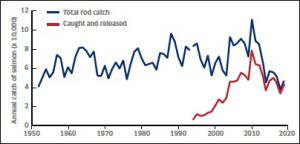
Typically, whenever hard evidence about the impact of salmon farms on wild fish is requested, the wild fish sector always redirect the issue towards sea trout. The argument is that as salmon migrate away from the coast, any direct mortality is less apparent. By comparison, sea trout tend to remain in coastal waters, so impacts are more easily measured. Most discussion about sea trout always reverts to what happened in Loch Maree. However, as I have regularly pointed out, sea trout catches have been in decline since records began in 1952 and I would argue that whatever caused the declines prior to the arrival of salmon farming, has probably continued to be the reason for declines of sea trout since. However, what is interesting is that since the advent of salmon farming, the rate of decline has slowed.
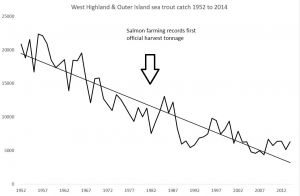
I am still waiting for anyone from the wild fish sector, or even Marine Scotland Science, to explain why this graph (drawn from MSS catch data) would indicate that salmon farming is to blame for declines of sea trout.
In their document about the use of rod catches to measure the impact of salmon farming, Marine Scotland Science do admit that ‘analysis of the catch statistics is not consistent with there being an impact of salmon farming on wild sea trout’. Their graph shows that catches as a percentage of total sea trout catches increase with increasing salmon production.
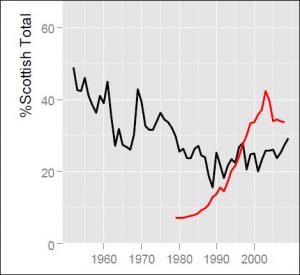
The trend in this graph clearly does not match that of my graph. This is because the MSS graph takes into account sea trout catches elsewhere and the simple truth is that sea trout catches are also in decline across all of Scotland, including areas where there is no salmon farming. MSS’ graph of sea trout catches for all Scotland shows a clear downward trend.
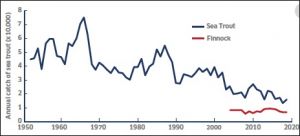
Like much of the wild fish sector, Mr Smith is calling for an end to open pen salmon farming to help protect wild fish. Before the industry is forced to spend a fortune on new technology, is it too much to ask that Mr Smith should provide some proper evidence to support his claims? When I ask for evidence, I don’t mean some ‘peer-reviewed’ mathematical modelling as widely used in Norway.
Let us not forget that whilst Mr Smith and the wild sector appear reluctant to provide data showing salmon farms have killed wild fish, Scottish Government data shows that since 1952, around 5.9 million wild fish caught from Scottish rivers have been killed by anglers. Rather strangely, there is little outcry against these confirmed killings. They do not even merit a mention on Marine Scotland Science’s list of pressures on wild salmon.
Finally, and although by the time this commentary is posted, the elections will have taken place, it was interesting to see that Mr Smith had included the Green Party’s plans for salmon farming on his Facebook page as they intend to phase out net pen farming, which is what Mr Smith would also like to see.
However, it looks like Mr Smith has not bothered to read the rest of the Green Party plans because they include the following:
![]()
(AR424. The Green Party is fundamentally opposed to all blood-sports. We oppose the killing of, or infliction of pain or suffering upon, animals in the name of sport or leisure and will work to end all such practices.)
Perhaps if he had, he might not be so keen to promote the Green Party’s plans.
The prize: Despite the lack of any conclusive evidence that salmon farming is having an impact on wild salmon – and I would welcome any evidence if it does exist – the wild fish sector continues its crusade against the salmon farming industry with the start of the west coast tracking project. Last week a couple of images were posted on Twitter showing one of the fish used in the study as well as of one of the tags before it was inserted into a fish.
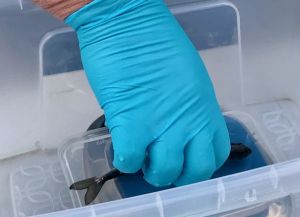

This seems a very large tag to insert inside such a small fish. Such large tags are needed to ensure that the signal is sufficient powerful to be detected by the receivers. I wouldn’t be surprised if most of these tags end up inside the belly of one predator or another as I would imagine the fish are slowed down by carrying such a burden.
One of the lead organisations running the west coast tracking project is the Atlantic Salmon Trust. They say on their website that ‘the Atlantic Salmon Trust is the foremost evidence-based salmon conservation charity in the UK. Fighting to halt the dramatic decline in wild Atlantic salmon stocks, the Trust is on a mission to protect this iconic species and safeguard their future.’
Funding research appears to be a continuing issue for the AST as they are currently running a prize draw to raise £50,000. At the time of writing, they have only raised £8,750 with less than 20 days to go. Perhaps the £50 for a ticket is a bit too much for many, even though the prize is worth over £12,000. The prize is a fantastic fishing experience for two on the East Ranga River in Iceland, fishing six half day sessions over four days, complete with guides and accommodation but not flights.
The East Ranga River is one of the most productive salmon rivers in the world with a five year catch average of 4,300 fish and an all-time record of 9,070 salmon. This record catch was landed over just 125 days in 2020. That is the equivalent of 72 fish a day.
What the AST do not mention on their website is that the East Ranga fishery does have some rules that anglers must follow. The first of which is that there is a maximum kill limit of 4 fish per rod per session. This means that the winner of this prize and their guest can catch and kill a whopping 48 fish during their four-day visit.
Wasn’t there some mention somewhere in this prize draw about raising funds for the protection of this iconic fish?
Schrödinger’s cat: (with thanks to Aquablogg.no) Regular readers of reLAKSation may remember that from time to time, I have discussed the 2013 Irish smolt release study, which found that the mortality of migrating salmon smolts was about 1%. At the time, this result was not well received by those opposed to salmon farming. A group of scientists including Martin Krkosek, Crawford Revie, Bengt Finstad and Chris Todd published a response in the Journal of Fish Diseases in which they said that the Irish paper would incorrectly lead the reader to the conclusion that sea lice play a minor, even negligible, role in salmon survival. They then said that this conclusion can only be supported if the reader accepts three fundamental mathematical errors. By way of a reply, the Irish Marine Institute subsequently issued an explanatory rebuttal of this criticism, which can be seen at https://vimeo.com/83845976
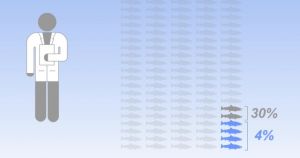
The video questions the claim that 30% of salmon die from sea lice. The problem is that there is a clear flaw when this statistical figure is applied to real life. At the moment, we know that at least 95% of wild salmon fail to return to freshwater, irrespective of whether they come from a salmon farming area or not. The addition of 1% mortality due to sea lice means that in salmon farming areas, the return rate could be just 4 not 5%.
However, if the alterative view of 30% mortality due to sea lice is accepted, then when this figure is added to marine mortality of 95%, the total mortality would be 125%, which is impossible.
The latest Aquablogg commentary also highlights a similar impossibility. In 2017, the lice induced mortality in the Vikja was modelled at 62%. The catch mortality in the river was 34% and the spawning stock was estimated at 9%. This totals 105% and this figure does not include predation and other forms of mortality. Something is clearly not right, and this undoubtedly is the modelled mortality from sea lice.
I am happy to repeat parts of the Aquablogg commentary because it raises a fundamental question that should be shared as widely as possible and this is that just because the lice induced model says that salmon have died from sea lice, does not mean that they actually have.
Aquablogg uses the example of Schrödinger’s cat to make the point.
In 1935, physicist Erwin Schrödinger questioned the paradoxes that arise from some aspects of trying to unify quantum mechanics with Einstein’s theory of relativity. These imply that atoms and other particles can exist in several different states at the same time in a so-called superposition. He proposed a thought experiment in which a cat is locked in a sealed box with a radioactive source that with a 50% probability will emit a particle within an hour. If the particle is released it will kill the cat.
However, before the box is opened, there is no knowledge of whether the cat is dead or alive, so theoretically, is in a state where it is both dead and alive. Schrödinger said this was absurd.
In exactly the same way, sea lice mortality modelers say that there is an impact, regardless of whether the lice, or the salmon, are actually observed. Aquablogg suggests that most people probably think that a phenomenon that cannot be observed or measured probably does not exist. Yet, sea lice modelers persist in maintaining that wild fish are dying from sea lice for no other than because their model says so.
At the moment, the best observation we have is the results of the Irish, and a similar Norwegian study, that about 1% of migrating salmon die from sea lice. Unfortunately, the wild fish sector appears to reject these findings because it doesn’t fit their accepted narrative that salmon farming is causing high mortality of wild salmon.
Even Marine Scotland Science seem to have an issue with the Irish study. The latest version of their summary of science about sea lice, does not reference the 2013 Irish study, but cites the research groups earlier paper from 2011. MSS just lumped it together with a number of other studies including those that claim up to 39% mortality (equivalent of 134% total mortality) without any supporting discussion.
Clearly, Marine Scotland Science have not yet heard about Erwin Schrödinger and his cat.

